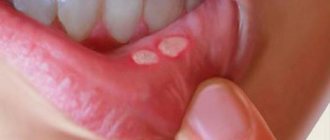Food allergy is a lack of tolerance to common foods caused by an immunological reaction of the body. A type of this pathology is its gastrointestinal form, which is characterized by damage to the mucous membrane of the digestive tract and can affect any part of the gastrointestinal tract. It is not so easy to differentiate, since it has similar symptoms to disorders of the gastrointestinal tract, and may be the only sign of an allergic response.
Gastrointestinal manifestations of food allergies in children occur most often between one month and three years. The younger the child, the stronger their severity will be.
Mechanism of development and features of gastrointestinal food allergy
An immune reaction that can exclusively affect the gastrointestinal tract is extremely rare; more often it affects other systems and organs. Most often, gastrointestinal syndrome is accompanied by gastrointestinal problems associated with skin or respiratory symptoms. There is also a dependence of manifestations on the level of sensitivity and age of the person.
The digestive system digests, absorbs, and utilizes food components. In everyday life, the gastrointestinal tract encounters many substances that can be perceived as allergens. Gastric juice and produced enzymes reduce the provocative properties of allergenic foods.
Immunity with the help of immune cells provides complete protection against foreign substances - antigens. When an allergen enters the body, immunoglobulins of group E, which are located on the membranes of immune cells, come to the defense. Upon secondary contact with the allergen, immune complexes are formed that cause the destruction of cells and tissues. At this moment, histamine and serotonin are released into the bloodstream, and they, in turn, cause allergic manifestations of various types: inflammation, vomiting and pain, loose stools, swelling of the gastrointestinal mucosa.
Occasionally, during the formation of gastrointestinal allergies, immune responses may occur that are caused by immunoglobulins other than group E. During immunocomplex processes, IgG, IgM are produced, immune complexes are created and activated, which causes the release of allergy provocateurs into the bloodstream and leads to the formation of immune inflammation in the gastrointestinal tract.
During cellular reactions, T-lymphocytes come to the defense and cause allergic inflammation.
A little about statistics and food allergens
Allergies caused by food components occur in 8% of children under three years of age. As the child gets older, the incidence of symptoms caused by food components decreases (in adolescence it is only about 4%). In 35% of cases we are talking about a true allergy, in 65% - about a pseudo-allergy.
Half of people with food allergies have a gastrointestinal form. In 92% of cases, gastrointestinal disorders are combined with pathologies of other organs and systems of the body. The isolated form occurs in only 10% of children. It is difficult to diagnose because it has no noticeable connection with food intake.
Main allergens of food components
| Plant origin | Animal genesis |
| soybeans, peanuts, beans, peas, lentils | cow's milk |
| wheat, rye, barley, corn | goat milk |
| nuts | eggs |
| berries, fruits and vegetables of red, orange color: strawberries, raspberries, strawberries, peach, apricot, persimmon, melon, avocado, tomatoes, carrots, beets, as well as kiwi, grapes and citrus fruits | seafood, fish |
Currently, about 160 different allergens are known.
The most common antigenic products
| Product | Prevalence of pathology | Stimulus |
| Cow's milk | It appears in 87% of babies during the period from birth to 12 months, more often after replacing breast milk with artificial compounds. And in 79% of babies - in the period from 12 to 36 months. | It has about 20 antigens with a high sensitivity potential. The main allergens are whey and casein parts. Cow's milk is used to make many products. |
| Egg | Occurs in 87.2% of cases. | The main sources of allergies are ovomucoid, ovalbumin, conalbumin and lysozyme. The yolk has a lower allergenicity than the white. There may be cross-reaction to other types of eggs. |
| Fish | 10% have a negative response to certain varieties, perhaps to all types of fish. Sensitization persists throughout life | When exposed to heat, allergenicity is not lost or reduced, but vice versa. The most active proteins are fish sarcoplasm, especially M-paralbumin. |
| Cereals | Causes both true allergies and gluten intolerance | Rye and wheat are considered highly allergenic due to their gluten content. It is included in a significant number of products |
| Vegetables fruits | It is recorded in 0.9–21% of children of preschool and school age. | Highly allergenic: strawberries, strawberries, quince, raspberries, apricots, cherries, citrus fruits, tomatoes, celery, carrots. |
| Mushrooms | 22% of children develop a response to nutrition using mushrooms: kefir, yogurt, baked goods, kvass | Used to make many food products. |
| Food contaminants | Provoke both true and pseudoallergic reactions | Dyes, emulsifiers, flavors, stabilizers, preservatives. Contained in all manufactured products. The most dangerous are tartrazine, ethylene, metabisulfite, monosodium glutamate |
Quite often, cross-reactions occur not just to individual products, but to all products with a similar amino acid composition. Often, previous pollen allergies and reactions to latex can also cause sensitization to certain products.
Gastrointestinal allergies in children
Gastrointestinal allergies in children
The problem of food allergies has concerned both doctors and their patients for many centuries. The first indications of unusual reactions to food come from the time of Hippocrates, who described gastrointestinal and skin symptoms that arose from drinking cow's milk.
Food allergy is a form of food intolerance.
Food intolerance
is a pathological reaction of the body to food products.
Food allergies
is an immunologically mediated food intolerance or a state of hypersensitivity to foods.
The highest prevalence of food allergies is observed among children in the first 2 years of life. Thus, the prevalence of food allergies in developed countries among children of the first year of life is 6-8%, and in adolescence - 2-4%.
The leading role in the development of food allergies belongs to immunoglobulin E. Currently, about 160 food allergens are known that can induce immunoglobulin E-mediated reactions.
The so-called “big eight” most allergenic foods include:
- Cow's milk
- Egg
- Fish
- Wheat
- Peanut
- Soybeans
- Crustaceans (shrimp, crayfish, etc.)
- Nuts (hazelnuts, walnuts, almonds).
The above products account for 90% of all allergic reactions to food.
Common allergens also include:
- Cocoa and chocolate
- Citrus
- Strawberry wild-strawberry
- Honey
- Meat of animals and birds
- Caviar
- Cereals
Typically, the first foreign protein introduced into a child's diet is cow's milk.
It contains about 20 antigens, of which the following are considered the most allergenic - casein, β-lactoglobulin, α-lactaalbumin, bovine serum albumin. It should be noted that pasteurization can increase the allergenicity of cow's milk. Powdered milk has more pronounced antigenic properties than natural milk.
Egg
. Egg white contains about 20 allergens. Yolk is considered less allergenic. It is known that half of children with an allergy to chicken egg whites tolerate small amounts of egg whites in bread, cakes, and cookies. And 70% of children over 5 years old can tolerate boiled chicken eggs.
N. _ B !!!
If you are allergic to chicken eggs, allergic reactions to vaccinations with vaccines containing residual admixture of chicken embryo tissue (for example, influenza vaccines) are possible
.
Fish.
Fish allergens are boil-resistant and volatile, so allergic reactions are possible even to the smell of fish.
It has not yet been fully established why, normally, our body does not have an active immune response to the introduction of many food antigens that constantly enter through the gastrointestinal tract. The development of food allergies depends on many factors. Let's list some of them:
- Genetic predisposition
- Child's age
- The beginning, and most importantly, the duration of breastfeeding
- Dose and nature of the allergen administered
- Immune system status
- Condition of the gastrointestinal tract
- Intestinal microbiocenosis
Clinical manifestations
food allergies are varied. Symptoms depend on the “shock” organ.
For young children (up to 3 years), the most typical skin forms are: atopic dermatitis, Quincke's edema, urticaria. Gastrointestinal disorders are also typical - excessive regurgitation and vomiting, colic, diarrhea or constipation. More rare cases include manifestations from the ENT organs and breathing (allergic rhinitis, apnea, bronchial asthma), severe anaphylactic reactions requiring resuscitation measures.
The gastrointestinal form ranks second in the structure of pathology associated with food allergies.
Symptoms of gastrointestinal tract damage due to food allergies rarely occur in isolation, more often in combination with skin damage.
The following clinical forms of gastrointestinal allergy are distinguished:
Oral allergy syndrome
often develops in response to ingestion of chicken eggs, fish, nuts and legumes. Symptoms are short-lived and develop within minutes of exposure. There is itching in the mouth, pharynx, swelling of the lips, tongue, and palate.
Enterocolitis induced by dietary proteins
accompanied by damage to the small and large intestines. Manifested by vomiting and profuse diarrhea with the development of severe dehydration. Basically, these are children in the first months of life. Symptoms do not appear immediately, 1-10 hours after consuming the product. They disappear on average three days after eliminating the allergen. Enterocolitis is caused by cow's milk and soy in children of the first year of life; in older children - eggs, cereals (wheat, rice, corn) and legumes. Enterocolitis often occurs in breastfed infants. It is believed that foreign proteins, for example cow's milk proteins, which are subsequently consumed by the mother, enter the milk and cause food allergies in the child.
Proctitis induced by food proteins -
damage to the rectum. Diagnosed in children in the first months of life and manifested by the appearance of blood in the stool against the background of good health. Common causes include soy and cow's milk based formulas.
Dietary protein-induced enteropathy
accompanied by diarrhea (diarrhea), vomiting and insufficient weight gain. A special case of enteropathy is celiac disease induced by dietary protein - gliadin, contained in cereals (wheat, barley, oats, etc.).
Eosinophilic gastroenteritis
affects patients of all ages. Symptoms are varied: abdominal pain, vomiting, diarrhea, weight loss, blood in the stool. The diagnosis is helped by an increased level of eosinophils in a general blood test, as well as data from a histological examination of a biopsy of the mucous membrane of the stomach and intestines, taken during fibroesophagogastroduodenoscopy. Many eosinophils are found in the mucous membrane, that is, eosinophilic infiltration is observed.
Eosinophilic esophagitis
characterized by the presence of persistent regurgitation and vomiting, which are not treated with traditional antireflux therapy. In addition, anemia due to hidden bleeding, weight loss, and impaired swallowing (dysphagia) may be observed in the clinic.
Age-related features of damage to the digestive tract due to allergies in children.
In young children (up to 3 years), abdominal pain (colic), flatulence, regurgitation, vomiting, frequent stools up to 5-8 times a day, liquefied stools, mixed with mucus, and rarely streaked with blood, are more common.
In children aged 3 to 6 years, gastrointestinal allergies are manifested by heartburn, nausea, vomiting, and diarrhea. Their abdominal pain is less intense.
In children aged 6 to 14 years, the clinical picture is blurred, with abdominal pain, constipation, belching, nausea, and heartburn.
Diagnosis of food allergies
is based on the diagnostic algorithm proposed by Eigenmann P. (2004).
First, we identify products that are “suspicious” in relation to food allergies, clarify the symptoms that arise when consuming these products, the time of their occurrence, their similarity, as well as the duration of the symptoms.
If the “culprit” product is identified, a diagnostic elimination diet
(with the exception of the “guilty” product). If it leads to an improvement in the condition and the appearance of an allergic reaction after repeated administration of the antigen (provocation), the diagnosis can be considered reliable.
A great help in diagnosing food allergies is the systematic keeping of food diaries by parents or children, which help to identify the connection between clinical symptoms and the quality and quantity of food consumed.
Skin testing is preferred when diagnosing a food allergy initially.
Skin testing can only be done in a medical facility!
Treatment of children with food allergies
WHAT ARE THERE ARE DIETS?
The leading component in the treatment of food allergies is diet therapy
, promoting the elimination (elimination) of causally significant allergens. There are three main types of elimination diets: empirical, elemental, and maintenance. Despite the restrictions, any diet must meet age-related needs for basic food ingredients - proteins, fats, carbohydrates, vitamins and microelements.
Important! The effectiveness of elimination diets cannot be assessed immediately, but only after 2-6 weeks.
Empirical diets
They are diagnostic in nature and are prescribed at the first stage of diet therapy. Hypoallergenic, dairy-free, lactose-free diets are used as such diets.
Elemental Diets
are prescribed for polyvalent allergies (simultaneous intolerance to several foods
)
and the ineffectiveness of empirical diets. They are usually represented by amino acid mixtures and products prepared from protein hydrolysates.
Maintenance diets
are as close as possible to physiological nutrition, are prescribed for a long time, sometimes for life.
Please note: The duration of exclusion of a significant allergen is at least 1-2 years!
Expansion of the diet is possible after the specified period and only after a repeat allergological examination. After 1-2 years of following an elimination diet, approximately a third of children lose hypersensitivity to food allergens.
In case of confirmed allergies to chicken eggs, nuts, legumes and seafood, an elimination diet is prescribed for at least 2 years.
FOOD RULES
Rule 1.
When a child is allergic to many foods, it is most appropriate to eat those foods to which an allergy has not been established, because excessive exclusion of most foods can lead to malnutrition. Also, when prescribing a diet, it is necessary to take into account the presence of food allergens in other products. (see table)
List of food products containing the most common allergens (A. N. Pampura, 2007)
| Allergen | Food products |
| Milk | Butter, buttermilk, cheese, cream, cottage cheese, custard, nougat, pudding, kefir, fermented baked milk, curdled milk, protein concentrate, yogurt, chocolate, margarine |
| Egg | Egg powder, mayonnaise, meringue, flour products, cookies |
| Wheat | Bread, bran, crackers, high protein flour, malt, wheat bran, wheat starch, natural colors, soy sauce |
| Soybeans | Hydrolyzed vegetable protein, soy sauce, soy flour, tofu, natural colors, vegetable broth, vegetable starch, sausage |
| Peanut | Peanut oil, ground nuts, nut mixtures, peanut flour. May be found in ethnic dishes (Chinese, Thai cuisine), baked goods. Chili sauce, chocolate, hydrolyzed vegetable protein, marzipan, nougat. |
Rule 2
In cases where food allergies are detected in breastfed children, it is necessary to preserve mother's milk in the child's diet to the maximum extent. Complementary foods are introduced no earlier than 6 months.
A nursing woman is prescribed a hypoallergenic diet: dairy products are limited and consumed in the form of fermented milk drinks, sour cream and mild cheeses. If there is an allergy to cow's milk protein in a child, the mother is prescribed a dairy-free diet, then it is advisable to use specialized products for nursing mothers based on soy protein isolate or goat's milk.
A hypoallergenic diet is prescribed to nursing mothers for the entire period of breastfeeding!
Rule 3
If a child with an allergy to cow's milk protein is on mixed or artificial feeding, the question arises: “Which formula should I prefer?” According to modern recommendations, during the period of clinical manifestations of food allergies, it is most advisable to prescribe mixtures based on highly hydrolyzed milk protein
.
It is known that, in comparison with cow's milk proteins, which have a high molecular weight, the allergenicity of the protein component of products created on the basis of highly hydrolyzed protein is reduced by tens and hundreds of thousands of times. But even in their composition it is possible to retain residual amounts of protein antigens, which can cause allergic reactions. All products in this group are enriched with a complex of vitamins, macro- and microelements and meet WHO requirements for ingredient composition, biological and nutritional value, and influence on the physical and psychomotor development of children in the first year of life.
Products based on highly hydrolyzed protein differ in the starting substrate that is hydrolyzed. There are mixtures based on whey protein hydrolysates and casein hydrolysates. There are certain differences between them in the fat and carbohydrate components and vitamin composition. Taking into account the characteristics of each mixture allows you to select a product in accordance with the individual characteristics of the clinical picture of the disease.
It is also necessary to take into account the presence of lactose in the mixture, since an allergy to cow's milk protein is often accompanied by partial or complete lactose intolerance. In such cases, it is advisable to prescribe a mixture based on highly hydrolyzed protein, low lactose or lactose-free.
Another group of products used in the nutrition of children with allergies to cow's milk proteins are soy formulas. Since these mixtures are potentially allergenic, their use in children with food allergies is limited, especially in the presence of a gastrointestinal form of allergy.
If the above highly hydrolytic mixtures are ineffective, amino acid mixtures are prescribed.
Rule 4
The duration of exclusion of infant formula and dairy products from the diet of children with food allergies varies from person to person. The minimum duration of dairy-free nutrition in children with an allergy to cow's milk proteins is 3-6 months.
Important! The elimination diet for a young child should be reviewed at least once a year.
Dairy products are introduced into the diet, starting with mixtures based on partially hydrolyzed protein. A gradual transfer to hypoallergenic mixtures is possible in the absence of exacerbation of the disease.
Fermented milk and probiotic products are used in the diet of children with allergies to cow's milk protein only at the second stage of diet therapy - during the period of expansion of the dairy-free diet.
Rule 5
When prescribing complementary foods to patients with food allergies, the severity, severity and form of the allergic disease, and the age of the child should be taken into account.
During the period of exacerbation of clinical manifestations of food allergies, complementary foods are not introduced!
When introducing complementary foods to children with food allergies, the following is necessary:
- Individual selection of foods and complementary foods.
- Use of single-component products and industrially produced dishes.
- Use of hypoallergenic products.
- Individual introduction of complementary foods.
- Dairy-free, gluten-free porridges (rice, buckwheat, corn).
- If you are intolerant to beef, which has antigenic affinity with cow's milk proteins, it is recommended to use specialized canned children's meat from rabbit, turkey, horse meat, and lean pork.
- As a third complementary food (from 8-9 months), it is possible to use a second vegetable or vegetable-cereal dish (zucchini with rice cereal, cauliflower with buckwheat in a 1:1 ratio) with the addition of meat puree.
- Among fruits, preference is given to green and white apples. The remaining fruits are introduced taking into account their tolerance. Heat treatment of fruits and berries reduces their allergenicity.
- Cottage cheese, eggs and fish are not included in the diets of children with food allergies in the first year of life.
When remission of an allergic disease is achieved, the hypoallergenic diet should gradually expand. Highly allergenic foods (fish, nuts, chocolate, honey, coffee, cocoa, mushrooms, etc.) are not introduced into children's diets for a long time.
Along with diet therapy, medication methods are used to treat food allergies.
Antihistamines, membrane stabilizers, and local treatment for skin forms are used.
The choice of drug and duration of treatment is determined only by the doctor!
In conclusion, I would like to note that despite the difficulties of diagnosing and treating food allergies, optimal dietary correction, sometimes even in the absence of drug treatment, allows not only to achieve recovery, but can also improve the psychological and emotional state of sick children and their parents.
Risk factors and risk groups
The provocateur of gastrointestinal manifestations can be:
- hereditary predisposition;
- unfavorable conditions for the fetus during pregnancy: exacerbation of chronic diseases, infectious diseases, metabolic disorders in the mother’s body, her abuse of highly allergenic foods, gestosis, fetal hypoxia, threat of miscarriage, premature birth;
- bad habits of parents, especially maternal smoking during pregnancy;
- delivery by caesarean section - intestinal microflora is disrupted;
- early cessation of breastfeeding;
- improper introduction of complementary foods: early, in large quantities or with inappropriate products;
- immaturity of the child’s digestive and imperfect immune systems;
- unfavorable environmental conditions.
- uncontrolled use of medications;
- frequent diseases leading to a decrease in the body’s immune forces.
Risk groups include infants and young children, since their conditions depend on:
- maturity of the body;
- enzyme deficiency;
- concomitant diseases;
- incidence of diseases;
- antigenic load of food ingredients.
For older children, the danger lies in the influence of intestinal parasites, viruses, and pathogenic microorganisms.
Allergy as a phenomenon - risk factors
From the outside it always seems that food allergies, like all others, arise on their own.
But in fact, this is not the case and it has its own group of factors and reasons that can trigger the development of its gastrointestinal form in children.
- Genetics. Genetic predispositions to diseases, including allergic reactions, are inherited. Therefore, if one of the parents or close relatives at one time suffered or still suffers from this disease, then there is a high probability that it will be passed on to the child.
- Antenatal factors. If the expectant mother was ill during pregnancy, had excessive contact with any allergens, abused bad habits, or was treated with antibiotics, this could affect the development of the fetus.
- Caesarean. It may seem strange, but childbirth through cesarean section can lead to gastrointestinal disturbances in the baby, which means making him more vulnerable to food allergens.
- Artificial feeding. Comments will be unnecessary here.
- Hygiene. A small number of microbes in contact with the immune system and excessively good living conditions can also lead to increased sensitivity to allergens.
These factors can in one way or another affect the child’s development, if not of the allergy itself, then of a predisposition to it and an increase in the sensitivity of the gastrointestinal tract to allergens.
Gastrointestinal food allergy itself is characterized by the following parameters:
- low oral tolerance to food allergens,
- allergic reactions are concentrated in the gastrointestinal tract,
- development of inflammation of the gastrointestinal mucosa.
The main reasons for the decrease in oral tolerance are the general immaturity of the young child’s body and, as a consequence, insufficient production of enzymes necessary for the proper functioning of the gastrointestinal tract. Recent illnesses can not only contribute to, but also aggravate the course of an allergic reaction.
Types of reactions
Allergic reactions of the gastrointestinal form are divided into:
- IgE-mediated;
- non-IgE-mediated;
- immune complex and cell mediated.
The first type of response occurs as a result of the interaction of group E antibodies. Complexes are formed in the area of mast cells and basophils, as a result of which inflammatory provocateurs are released. This process can take place from a few minutes after contact with the allergen to several hours.
Forms of gastrointestinal syndrome
Depending on the degree of sensitivity, various forms of this type of reaction are distinguished.
| Form | Pathology | Signs |
| IgE-dependent diseases | Rapid gastrointestinal hypersensitivity | The appearance of pain, vomiting, and attacks of nausea immediately after taking an allergenic product. Stool liquefaction occurs after a few hours. May be accompanied by other manifestations. |
| Oral allergy syndrome (OSA) | Redness, itching formations in the oral cavity, swelling of the oral mucous surfaces. Signs appear immediately after ingestion of the allergen. | |
| Mixed IgE- and non-IgE-dependent | Eosinophilic esophagitis | Pain syndrome, nausea, vomiting syndrome, stool disorders. No improvement with conventional therapy. |
| Eosinophilic gastritis | ||
| Eosinophilic gastroenteritis | ||
| Eosinophilic gastroenterocolitis | ||
| Cell- mediated diseases | Enteropathy caused by dietary proteins | Prolonged diarrhea, vomiting syndrome, bloating, weight loss. More often in newborns (BG and artificial) |
| Proctocolitis caused by food proteins | There is mucus or blood in the stool. Infants are susceptible. In 60% of cases it occurs in babies fed on mother's milk. | |
| Enterocolitic syndrome (FPIES) | Renewed vomiting, liquid feces, pallor, low blood pressure. Signs appear when cow's milk is first introduced. | |
| Hayner's syndrome | Colic, bloating, vomiting, cough, wheezing, difficulty breathing. It appears during the initial inclusion of cow's milk or its products. |
Symptoms
The disease occurs in childhood. It is extremely rare that it manifests itself only in gastrointestinal pathologies. Basically, it can be accompanied by respiratory symptoms: rhinitis, tracheitis, asthma, as well as skin symptoms: rashes, redness, itching, Quincke's edema.
In infants under one year of age, symptoms occur when they initially include products containing cow's milk or use milk substitutes. The signs are:
- constant regurgitation;
- flatulence;
- colic;
- constipation;
- body weight deficiency.
A complicated nature of the pathology may also occur, which is accompanied by inflammation of the rectum. Children behave extremely nervously and lose their appetite.
Typical symptoms in children under three years of age are:
- pain in the abdominal area (colic);
- bloating;
- bowel disorders;
- there may be blood or mucus in the stool;
- frequent regurgitation;
- gagging;
- invisible or visible bleeding, characterized by anemia.
Manifestations in preschoolers aged three to six years:
- increased heartburn, vomiting;
- Occasionally gas formation occurs, the consistency of the stool changes;
- pain syndrome is less pronounced.
Signs that appear during the school period:
- pain in the abdomen;
- belching, heartburn, attacks of nausea;
- securing the chair;
- decreased appetite;
- feeling of disgust towards the allergen.
These symptoms disappear when the allergenic product is excluded. Complicated forms of the disease are characterized by a severe deterioration in general condition, a high content of blood and mucus in the stool, continuous vomiting and pain.
If any of the listed symptoms occur, you should immediately consult a doctor.
Diagnostics
You need to consult a pediatrician, gastroenterologist and allergist.
To make a diagnosis, the doctor must examine the patient and collect anamnesis, clarify hereditary factors. Based on the results, he will, firstly, prescribe an elimination diet and recording food in a food diary. If exclusion, for example, of dairy products and meat has produced positive changes, then gradually the causative product is reintroduced in small doses. The occurrence of a pathological reaction indicates a correct diagnosis. If this method fails to achieve improvements, then additional diagnostic methods are prescribed.
Laboratory research
| View | What does it show |
| general blood clinic | increased content of eosinophils and basophils |
| coprogram | content of mucus and red blood cells in stool |
| endoscopy | esophagus → stomach → duodenum: pallor of mucous membranes, presence of grooves, sign of semolina |
| histology | ≥ 20 eosinophils per field of view |
| Allergy tests (scarification test, skin prick test) | swelling and redness of a certain area indicate an irritant |
| biochemical analysis to determine total Ig E | increased Ig E content |
| biochemical analysis for the determination of specific Ig E, Ig G4 | the presence of specific antibodies indicates an irritant |
Diagnosis, treatment
Difficulties arise during diagnosis due to the fact that:
- in case of delayed allergic reactions, the connection with food intake is not obvious;
- with concomitant lactose deficiency, the symptoms of GA are masked, and the child is mistakenly prescribed a lactose-free diet;
- when dysbiosis is detected, which almost everyone has with gastrointestinal allergies (in children in 96.5% of cases), drug therapy is prescribed without changing the diet.
Diagnosis is aided by keeping records of all foods given to the child and the time at which signs of an allergic reaction occurred.
The method of treating gastrointestinal allergies is a hypoallergenic diet, from which milk and beef are excluded. If there is no improvement after 2 weeks, the baby will be further examined.
In the case where the elimination diet has had a positive effect for 2 weeks and allergy symptoms have disappeared, the product is reintroduced into the diet in small quantities. When signs of GA appear, the test is considered positive, and the diagnosis is confirmed.
Food allergy is a lack of tolerance to common foods caused by an immunological reaction of the body. A type of this pathology is its gastrointestinal form, which is characterized by damage to the mucous membrane of the digestive tract and can affect any part of the gastrointestinal tract. It is not so easy to differentiate, since it has similar symptoms to disorders of the gastrointestinal tract, and may be the only sign of an allergic response.
Gastrointestinal manifestations of food allergies in children occur most often between one month and three years. The younger the child, the stronger their severity will be.
Treatment
Therapy primarily involves an elimination diet, that is, the exclusion of the causative allergen and all components that provoke an inadequate immune response. This nutrition is prescribed for a minimum of 8 weeks, and in certain cases for a longer or even lifelong period.
With age, a child may develop tolerance to certain foods (exceptions are fish, nuts). But if this does not happen before the age of 5, then the chance of tolerance developing in the future reaches a minimum level.
Diet during lactation
When breastfeeding, the mother must adhere to a strict diet that excludes possible sources of allergies and foods with individual intolerance. When feeding with milk replacers, medicinal formulations with complete protein hydrolysis (whey or casein) are recommended. It is not recommended to use soy mixtures during the period of allergic manifestations to cow's milk protein, since soy is its cross-product. If high breakdown milk replacers are not suitable, then amino acid formulations are prescribed. Complementary foods for gastrointestinal allergies should be introduced no earlier than six months and only with single-component products with a gradual increase in doses.
Symptomatic drug therapy is also prescribed, which includes:
- antiallergic: Zodak, Fenistil, Zyrtec, Erius, Edem, Tavegil and others;
- membranotropic drugs during the period of subsidence of symptoms: nalcrom, ketotifen;
- enterosorbing: enterosgel, polysorb, smecta, lactofiltrum;
- enzymes: pancreatin, mezim, creon, pancitrate.
- for bloating and colic - carminatives: espumisan, bobotik, espuzin;
- for vomiting syndrome: motilium.
All prescriptions, dosage, and course of treatment are determined exclusively by the doctor. It is important to remember that self-prescription or any unauthorized course changes can be harmful to your health!
Treatment of allergic enteropathy
In young children, allergic damage to the intestines is manifested by cramping pain in the abdomen like intestinal colic, regurgitation and vomiting, bloating, and loose stools 5-6 times a day. Sometimes intestinal bleeding may occur with a change in the color of the stool. The general condition of the child is disturbed:
Timely elimination of the allergen from the diet leads to the cessation of symptoms after 2-3 days. If allergic damage to the gastrointestinal tract is caused by hypersensitivity to cow's milk casein, the manifestations of enteropathy usually disappear by 2-3 years of age, even with regular consumption of dairy products.
In school-age children, adolescents and adults, the picture of the disease becomes more blurred and is often characterized by dull pain in the navel, flatulence, unstable stool (constipation or diarrhea), decreased appetite, and nausea. Extraintestinal manifestations of allergies are uncommon. At the same time, allergens that cause allergic enteropathy at this age can sometimes be not only food products, but also medications, plant pollen, household dust, etc.
If breastfeeding is carried out, it is necessary to prepare a strict hypoallergenic diet for the mother, excluding potential food allergens and individually intolerant foods. Children who are bottle-fed are prescribed special medicinal mixtures with whey and casein protein hydrolysates, as well as mixtures based on goat milk.
The timing of introducing complementary foods to children with allergic enteropathy is postponed until 5-6 months of life, while hypoallergenic porridges (buckwheat, rice, corn), one-component vegetable purees, meat (veal, horse meat, pork, rabbit, turkey) are used. Cow's milk, cottage cheese, fish and eggs are completely abandoned in the first year of life; peanuts are excluded until three years. Older children and adults follow an individually selected hypoallergenic diet for at least six months.
Among the antihistamines in the first year of life, the use of dimethindene (in drops), chloropyramine (in tablets), cetirizine (in drops), and also ketotifen is recommended. From the age of one you can use loratadine, and from the age of six - fexofenadine hydrochloride and ebastine. Enterosorbents are usually used for one to two weeks during an exacerbation.
Prevention
If a child has a genetic predisposition to allergies, then the following rules should be followed:
- During pregnancy and breastfeeding, adhere to proper nutrition, excluding possible allergenic foods.
- Eliminate bad habits: alcohol, smoking, overeating.
- Feed breast milk for as long as possible, at least up to six months.
- Introduce complementary foods in accordance with the age and characteristics of the toddler.
- Choose milk substitutes only with your doctor.
- Build tolerance to common allergens.
- Spend the maximum amount of time in favorable environmental conditions.
- Observe the work and rest schedule.
- Minimize stressful moments.
- Treat emerging pathologies in a timely manner.
How to treat?
When treating food allergies, like any other, it is better to use a combined approach, combining drug treatment with diet and preventive measures. It is not advisable to “prescribe” pills for yourself - this approach can make things even worse. Only a specialist can select a safe set of medications.
Diet for gastrointestinal allergies
If a mother is breastfeeding, then she is put on a strict hypoallergenic diet, selected individually. When artificial feeding, the pediatrician will most likely prescribe the use of medicinal mixtures as food.
Features of feeding a child
Feeding a child with gastrointestinal allergies should be done carefully, following a number of simple recommendations:
- You need to start complementary feeding after 5 months,
- vegetable puree and food at one time, if possible, single-component,
- hypoallergenic cereals, without added milk,
- from meat purees: turkey, lamb, beef, pork,
- Goat milk is prohibited, because due to the increased concentration of minerals it puts unnecessary stress on the digestive system.
Treatment and prevention
It is necessary to follow the treatment prescribed to the child by the allergist. If it is not possible to urgently go to see him, but you need to reduce the harmful effects of allergies now, you can use relatively safe antihistamines. For example, Fenistil or Suprastin, which can be taken already in the second month of a child’s life.
Other types of drugs and medicines that are usually prescribed by specialists include: membrane stabilizers, enterosorbents and enzymes. In cases where it is necessary to eliminate the unpleasant symptoms of gastrointestinal food allergies, they resort to narrow-purpose drugs. For attacks of vomiting - Motilium. And if you suffer from intestinal colic, then the Espumisan tablet is quite capable of saving the situation.
But it is better to prevent the development of food allergies in advance. Even better - before the baby is born. To prevent a newborn baby from being sensitive to various allergens, a woman during pregnancy is supposed to follow the principles of a rational diet that is close to the rules of a healthy diet.
It is also better to avoid exposure to so-called occupational hazards, and at the same time various diseases. Giving up bad habits (smoking and alcohol) will significantly contribute not only to the health of the child, but also to the expectant mother.
If favorable conditions and opportunities exist, it is advisable to breastfeed a newborn baby for up to six months. But early complementary feeding, on the contrary, is fraught with the development of intolerance and allergies to the products offered.
But there is no need to completely protect him from all allergic adversities: tolerance to allergens in children is formed at an early age and for life. Therefore, the first two years of a child’s life should be approached extremely responsibly, especially if there is a predisposition to allergic reactions in the family.
The difficulty of diagnosing gastrointestinal allergies lies in the similarity of its symptoms with disorders of the digestive tract. Gastrointestinal allergies are especially difficult to recognize when they are the only symptom of an allergy.
Food allergies in children are more common under 2 years of age (up to 8%). By adolescence, the incidence decreases, and in adolescents it is observed only in 4% of cases.
Gastrointestinal food allergy (GA) is a type of food allergy in children. It is characterized by damage to the mucous membrane of the digestive tract.
Of the 160 known allergens that cause gastrointestinal allergies, the most common are:
- cow's milk protein - about 20 allergens, including gamma casein and alpha casein S1, albumin;
- egg white – about 20 allergens;
- seafood, fish;
- cereals - wheat, rice, rye, buckwheat, oats;
- legumes - soybeans;
- fruits – oranges, apples;
- berries - strawberries;
- vegetables - beets, carrots.
The main factor determining the development of allergies in a child is hereditary predisposition. It is also important to stop breastfeeding, irrational introduction of complementary foods, as well as the state of the immune system.










